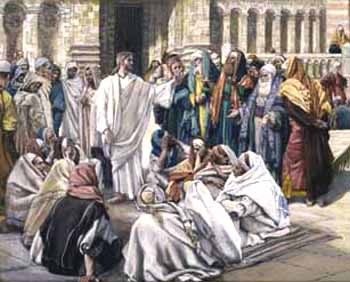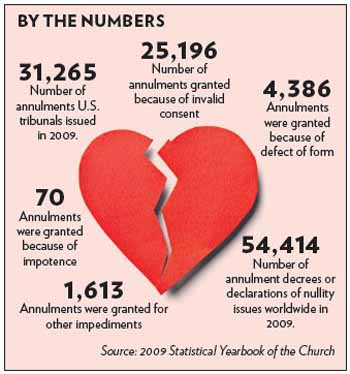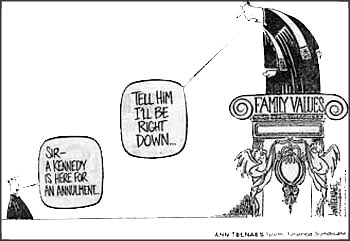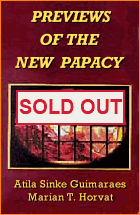Morals
 |
 |
 |
 |
 |
 |
 |
Snookering the Indissolubility of Marriage
In a book dealing with the problem of divorce published one year before Vatican II, this paradox is pointed out: “Just when the post-Christian world has entered into an unparalleled period of hedonistic ideals, and of contempt for such unprofitable notions as a world to come, self-control, and penance, Catholics have emerged from their own private enclave to become more a part of the world around them than they had been for centuries." (1)
It was with this world of "hedonistic ideals" that Vatican II merged, not to remedy the problem, but to insure its success. Its objective was to promote and accelerate the engine driving this hedonism by adding the dynamism of the Church to it. One field where its effects were clearly felt is Catholic marriage. To destroy the indissolubility off marriage is to destroy the august benefits of the family. In the annulment process, practically any pretext has been accepted to end marriages and the result is that some 60,000 annulments a year have taken place.
 An annulment made under the authority of Church is now a form of divorce in every way but name. The "Catholic divorce" is extremely harmful to the family and society. It hurts children as well as spouses, often induces applicants to misrepresent the past, and drives many away from the Church. It is a disaster.
An annulment made under the authority of Church is now a form of divorce in every way but name. The "Catholic divorce" is extremely harmful to the family and society. It hurts children as well as spouses, often induces applicants to misrepresent the past, and drives many away from the Church. It is a disaster.
In His Sermon on the Mount (Mt 5:31-32), Our Lord expressly forbade divorce, but the Jews rejected this precept forthwith. Passing through the district of Peraea, we see Him assailed by His bitter enemies, the Pharisees, who nowhere leave Him in peace. Having decided to hasten His death, they were always on the watch for some “error” on His part so they could condemn Him.
They thought they had found one on the subject of marriage. With hearts of malice, the Jews posed this question to Our Lord: “The great lawgiver Moses allowed divorce and remarriage. Do You deny the validity of the Law of this man of God?" (2)
Our Lord pointed out that Moses made this temporary concession because of the hardness of the Jews' hearts. He allowed divorce in some instances in the Old Law, but this temporary permission came to an end in the New Covenant. Thus, He reestablished the indissolubility of marriage in all its chaste beauty. (3)
Indissolubility of marriage was the rule of law in the Catholic Church from the time of Our Lord until Vatican II, when the agents of Progressivism devised a method to snooker Our Lord's command, that is, to place the indissolubility of marriage in an almost impossible situation.
This snookering is a great embarrassment to the traditional teaching of the Church, which is set out by Fr. Paul Sretonovic in two very useful articles on this site (here and here).
Inversion of the ends of marriage
Let me explain what I mean by progressivism snookering the indissolubility of marriage. Catholic teaching on marriage has two perspectives: a moral perspective and a judicial one.
As for the moral perspective, we have seen an inversion of the ends of marriage – mutual support of spouses and love put before procreation and the formation of offspring. This position finds grounds in the conciliar constitution Gaudium et spes (48-52). With this fundamental inversion, all of morals becomes inverted.
Since “love” is now considered to be more important than the progeny, there is an obvious encouragement to use contraceptives. This kind of dilemma is common: “To please her/him and maintain our marriage, we need to cohabitate, but we cannot afford more children. What should we do?” Almost all confessors will say: “Go ahead and use contraceptives.”
Another consequence of this inversion touches our topic directly: Since “love” became the main goal of the marriage, how is it possible to avoid the conclusion that when love ends, the marriage cannot be maintained? Thus, its indissolubility is greatly jeopardized.
 As for the juridical perspective, what followed was a general liberalization in marriage laws in the New Code Canon Law (1983), which did unspeakable damage and destroyed the Catholic stability of marriage. These laws, also introduced in the wake of Vatican II, are the main reason for the deluge of annulments we are witnessing. Traditional Catholics should be aware of these disastrous changes and resist them. You may read these laws and their interpretations here, here and here.
As for the juridical perspective, what followed was a general liberalization in marriage laws in the New Code Canon Law (1983), which did unspeakable damage and destroyed the Catholic stability of marriage. These laws, also introduced in the wake of Vatican II, are the main reason for the deluge of annulments we are witnessing. Traditional Catholics should be aware of these disastrous changes and resist them. You may read these laws and their interpretations here, here and here.
As Catholics who recognize the authority of the Pope and of the diocesan marriage tribunals, we accept those annulments as valid even though we do not agree with the lax criteria being applied. The laxity of our ecclesiastical tribunals do not make their decisions void. As Fr. Sretenovic points out, “Certainly the bad judges – in this case, the Bishops, the Rota Romana judges, and ultimately the Pope – will have to give an account to God for their decisions. But for the common Catholic, no other possibility remains but to accept them." (3)
Facing these facts, we see that the diocesan tribunals of the Conciliar Church snookered the indissolubility of marriage: They are making it impossible to maintain the traditional Catholic marriage, as emphasized in another article here.
Our Lord himself made the law forbidding divorce and remarriage. Pari passu He gave the Pope and Princes of the Church the judicial authority to nullify the bonds of marriage in exceptional cases, when there is proof of an impediment. Today impediments are considered to be almost anything. We almost can say that the rule - a stable marriage - became the exception, and the exception - an annulled marriage - is the rule.
Processes made easier and simpler
Consider that before Vatican II worldwide about 300 annulments a year were granted; but under the Conciliar Church the number jumped to 60,000 per year. A large proportion of these – 70% of the total - are in the United States.
 Certainly the whole process was made easier and simpler in our country. Up until 1969 annulment petitions could only be filed in the diocese where the wedding was celebrated. But in 1970 the Holy See approved nullity cases to be filed in the diocese where the filer currently lives. This allowed the person to have his petition heard in the tribunal most convenient to himself, which facilitated the process.
Certainly the whole process was made easier and simpler in our country. Up until 1969 annulment petitions could only be filed in the diocese where the wedding was celebrated. But in 1970 the Holy See approved nullity cases to be filed in the diocese where the filer currently lives. This allowed the person to have his petition heard in the tribunal most convenient to himself, which facilitated the process.
Another change allowed a single judge to hear a case instead of requiring three judges to hear each petition. New time limits for speedier annulments were imposed, and so on. (4). An expert in canon law boasted, “There is not one marriage in America that we can't annul” (5)
The result of this snookering of the old system we know: broken families and loss of faith by the tens of thousands. Our Lord Jesus Christ established the Sacrament of Marriage with its indissolubility. Progressivism is snookering the plan of God.

It was with this world of "hedonistic ideals" that Vatican II merged, not to remedy the problem, but to insure its success. Its objective was to promote and accelerate the engine driving this hedonism by adding the dynamism of the Church to it. One field where its effects were clearly felt is Catholic marriage. To destroy the indissolubility off marriage is to destroy the august benefits of the family. In the annulment process, practically any pretext has been accepted to end marriages and the result is that some 60,000 annulments a year have taken place.

Pharisees try to trick Our Lord on the question of divorce
In His Sermon on the Mount (Mt 5:31-32), Our Lord expressly forbade divorce, but the Jews rejected this precept forthwith. Passing through the district of Peraea, we see Him assailed by His bitter enemies, the Pharisees, who nowhere leave Him in peace. Having decided to hasten His death, they were always on the watch for some “error” on His part so they could condemn Him.
They thought they had found one on the subject of marriage. With hearts of malice, the Jews posed this question to Our Lord: “The great lawgiver Moses allowed divorce and remarriage. Do You deny the validity of the Law of this man of God?" (2)
Our Lord pointed out that Moses made this temporary concession because of the hardness of the Jews' hearts. He allowed divorce in some instances in the Old Law, but this temporary permission came to an end in the New Covenant. Thus, He reestablished the indissolubility of marriage in all its chaste beauty. (3)
Indissolubility of marriage was the rule of law in the Catholic Church from the time of Our Lord until Vatican II, when the agents of Progressivism devised a method to snooker Our Lord's command, that is, to place the indissolubility of marriage in an almost impossible situation.
This snookering is a great embarrassment to the traditional teaching of the Church, which is set out by Fr. Paul Sretonovic in two very useful articles on this site (here and here).
Inversion of the ends of marriage
Let me explain what I mean by progressivism snookering the indissolubility of marriage. Catholic teaching on marriage has two perspectives: a moral perspective and a judicial one.
As for the moral perspective, we have seen an inversion of the ends of marriage – mutual support of spouses and love put before procreation and the formation of offspring. This position finds grounds in the conciliar constitution Gaudium et spes (48-52). With this fundamental inversion, all of morals becomes inverted.
Since “love” is now considered to be more important than the progeny, there is an obvious encouragement to use contraceptives. This kind of dilemma is common: “To please her/him and maintain our marriage, we need to cohabitate, but we cannot afford more children. What should we do?” Almost all confessors will say: “Go ahead and use contraceptives.”
Another consequence of this inversion touches our topic directly: Since “love” became the main goal of the marriage, how is it possible to avoid the conclusion that when love ends, the marriage cannot be maintained? Thus, its indissolubility is greatly jeopardized.

As Catholics who recognize the authority of the Pope and of the diocesan marriage tribunals, we accept those annulments as valid even though we do not agree with the lax criteria being applied. The laxity of our ecclesiastical tribunals do not make their decisions void. As Fr. Sretenovic points out, “Certainly the bad judges – in this case, the Bishops, the Rota Romana judges, and ultimately the Pope – will have to give an account to God for their decisions. But for the common Catholic, no other possibility remains but to accept them." (3)
Facing these facts, we see that the diocesan tribunals of the Conciliar Church snookered the indissolubility of marriage: They are making it impossible to maintain the traditional Catholic marriage, as emphasized in another article here.
Our Lord himself made the law forbidding divorce and remarriage. Pari passu He gave the Pope and Princes of the Church the judicial authority to nullify the bonds of marriage in exceptional cases, when there is proof of an impediment. Today impediments are considered to be almost anything. We almost can say that the rule - a stable marriage - became the exception, and the exception - an annulled marriage - is the rule.
Processes made easier and simpler
Consider that before Vatican II worldwide about 300 annulments a year were granted; but under the Conciliar Church the number jumped to 60,000 per year. A large proportion of these – 70% of the total - are in the United States.

Another change allowed a single judge to hear a case instead of requiring three judges to hear each petition. New time limits for speedier annulments were imposed, and so on. (4). An expert in canon law boasted, “There is not one marriage in America that we can't annul” (5)
The result of this snookering of the old system we know: broken families and loss of faith by the tens of thousands. Our Lord Jesus Christ established the Sacrament of Marriage with its indissolubility. Progressivism is snookering the plan of God.
- Claire McAuley, "Whom God Hath Not Joined," Sheed and Ward, NY, 1961, pp. 5-6.
- Fr. L.C. Fillion, The Life of Christ - A Historical, Critical, and Apologetic Exposition, St. Louis: Herder Book Co., 1943, Vol. III, p. 156.
- Ibid.
- Edward N. Peters, “Annulments in America: Keeping Bad News in Context”.
- Sheila Rauch Kennedy, Shattered Faith, Holt Paperbacks, 1998, p. 12.

Posted August 29, 2012











